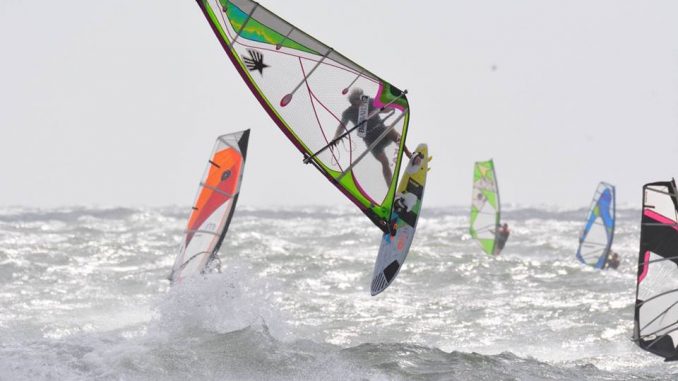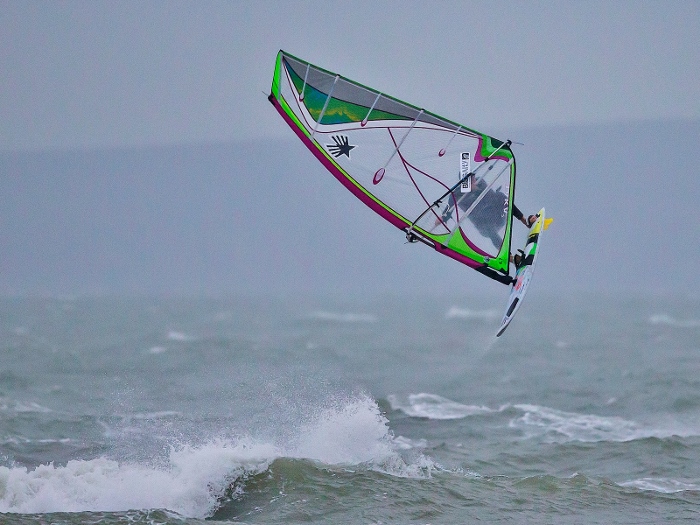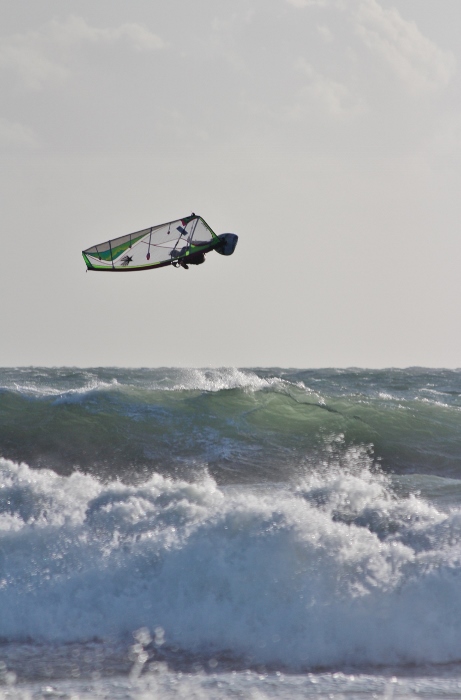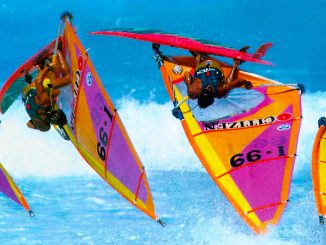
Words: James Cox (Bigsalty Weather)
Pics: Fergus Cowhig, Greg Dunnett, Jamie Hancock, Caroline Radway
We’ve talked about the forward on Windsurfing UK’s website. But with so many variations, and styles to the move, it’s always good to get some other perspectives and tips. James Cox, owner of bigsalty.com, talks us through injecting some nitro into your forward loops and controlling them when overpowered.
The forward loop is a beautiful move. It is arguably the easiest aerial move to learn but it will take a lifetime of dedication and we’ll never master it. It is a move you can pull on flat water or off of waves. In light winds or in strong winds. It’s a scary move to learn and initiate, yet in my experience it’s the least dangerous of all jumps in windsurfing. The rotation can be late or early, slow or fast and everyone will have a slightly different style. Learning it takes commitment and self-belief that for a small amount of physical effort is highly rewarding, so lets all agree to do more of them…
Most people learn forward loops on flat water and over the years I’ve tried to expand my knowledge of how to land them in a whole variety of conditions which has meant that I’ve continued to adapt my style (and different ways of crashing!).
What I aim for these days is to be well powered up and try and get the maximum height possible. Sailing on the south coast generally means hitting small ramps at high speed. And this way life stays very exciting. If we discard some of the tools we used to learn the forward loop in the beginning and embrace some new ideas it’s very easy to nitro inject our forward loops and at the same time take control when conditions get out of control.
Here are my key thoughts on this:
– Always have plenty of clearance before trying forward loops. You may well have to bail. So, look around and pay attention. If someone is close don’t bother as it will distract resulting in injury to you and/or them.
– Height is your friend. It improves technique and feels incredible. It also assists when you are overpowered. The higher you can get the more your forward speed will reduce. This also stops painful landings. Dropping down from up high will reduce forward momentum with a highly powered up rig. (Unless of course you have mastered the planing forward). But this is about getting height. If it turns in to a crash breaking the water tension with a foot or fist is easier than travelling at high horizontal speed. Focus on getting as high as possible.
– To get high you need to hit a steep wave, such as what we’d traditionally see as a backloop section. If you like to live on the edge go for a section with some white water on it, this will give you extra boost but may make your entry to the loop more complicated and random.
– A vertical launch off a steep wave will also have the effect of killing your forward speed (see previous point). It also has the effect of forcing you to be in a higher body position over your kit to initiate your rotation which offers more leverage, which you want.
– At the apex of your jump you have to decide in a split second whether you commit or not. This is the most exhilarating part of the move. If you decide to commit, it means believing that you are bigger than yourself. Your success is very much down to believing you can land it. And you have to want it!
– Jump, pull your body up and get as close as possible to your rig. This has the effect of putting you in a position of control and also should help de-power the sail.
– Once compact lean the sail in a downwind direction towards your landing position.
– By now you’re ready to throw your body round whilst pulling the sail with your back hand. Do not be shy here. If you have launched in to a vertical enough jump, pulling in with force with your back hand should create a more de-powered and tight rotation.
– At this point it might feel like you haven’t de-powered enough and you are completely out of control. If this is the case it would be a good idea to bail out, assuming nobody is downwind of you!
– Tuck in to the boom and start to feel the rotational speed you have and spot your landing to calculate your margin for error upon landing. This point is very much down to feel and to an extent experience. If it doesn’t work out, don’t worry – crash and keep trying.
– As you are dropping down extending your arms during this part of the rotation can slow down you down and leave you landing more upright for a softer touch down.
Now you will have either crashed or stomped it. Whichever almost doesn’t matter. You went for it and you went for it in the most radical way possible. You hit a vertical ramp at high speed and tried to go as high as possible. Pour yourself a gin and call yourself a winner!
James Cox is sponsored by Quatro International, Conker Gin, Bigsalty Weather, Ezzy Sails, K4 Fins






Leave a Reply